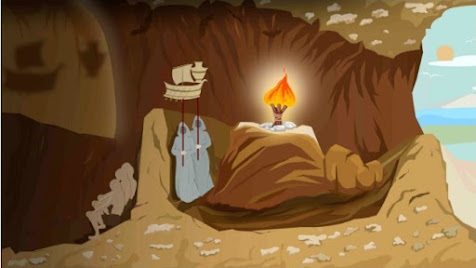Image credits : commonlit.org
One of the most critical and profound thought experiment pertinent to Plato's theory of form is Plato's allegory of cave. It has both political and ethical implications. But before we talk about meaning of Plato's allegory of cave, you should know that in Plato's ideas here resonates what is called as dualism.
Focus on the picture above, there are two important dimensions to it :
1. There is a wall and cavemen are chained in a way so that they are only able able to see the wall (ie in front of them). Behind them is a parapet where other (hooded) entities walk while carrying objects.
2. There is a fire 🔥 which causes shadow to be cast on wall of the objects carried by the hooded entities.
These objects are small figures of daily life that resemble the real world objects. However, the images cast a shadow on the wall and the cavemen only see the shadow of objects.
What does the shadow mean ?
Since the cavemen see only the shadow of the images. For them shadows constitute reality. One can assume from long they are subjected to it and they are unable to comprehend that images they are seeing is merely shadow of moving objects cast on by fire and moved by hooded entities. Plato calls this stage to be imagining (far from reality).
Perhaps this points reflects how far some people are from reality of things that shape around us. And that what we or others constitute to be facts are merely opinions created from what our cognition perceives to be as facts.
The cave is called world of appearances.
(George Orwell 1984 novel talks about it)
What happens when one of the caveman is freed to wander ?
If one the caveman is allowed to roam free. At first he would be blinded by light emanating from fire 🔥 . After sometime the caveman becomes accustomed to seeing the fire. He notices that moving objects are source of shadows cast on the wall. He now knows that what he was seeing earlier is merely images of objects. The caveman here understands how and what he was perceiving true to be merely images of moving objects. Plato describes this state as belief.
He calls them beliefs as they are still not real but merely a copy of real world objects. Hence even at this point the caveman is far from reality of things.
Caveman goes outside the cave
Again when he goes outside he is blinded temporarily by sunlight. Upon becoming accustomed he realizes that moving objects he saw in the cave were merely copies of reality that was all around him (the world). The living things constituted true knowledge and that inanimate copies were not the reality. he understands that shadows are the images of all things around him. And it is the sun which causes true nature of things to present themselves in light of sun around him.
This state is called true knowledge. Plato calls it true knowledge because caveman is no longer sees imperfect reality rather seen things as they are. At this point he sees perfect reality of things and reasons for why they are in a certain way (the order and harmony).
To sum up,
Most of the world lies in the ignorant category where what one sees is what one believes. This level is called imagining. Even after grasping how shadows cast image on wall the caveman being in cave seems to be away from reality. As he beliefs emanate from values and those values even at this level remains unchanged (I mean in the cave).
It is only when he ventures out he understands true nature of things and acquires knowledge. A knowledgeable person works in harmony and order.
To conclude,
The cave is realm of opinion. This means images after images cast a shadow. Most of us believe it to be truth and chase one shadow after another or dwell in it infinitely but ever changing. It is easier to remain in cave chasing shadows.
Plato's describes caveman enlightenment experience to be a painful one, problem is why is it painful ? Because its ethical. To acquire true knowledge one has to look beyond and become ethical (having temperance, virtue, courage, truth, honesty etc) to maintain order.


Comments
Post a Comment
If you like my article. Do tell me.